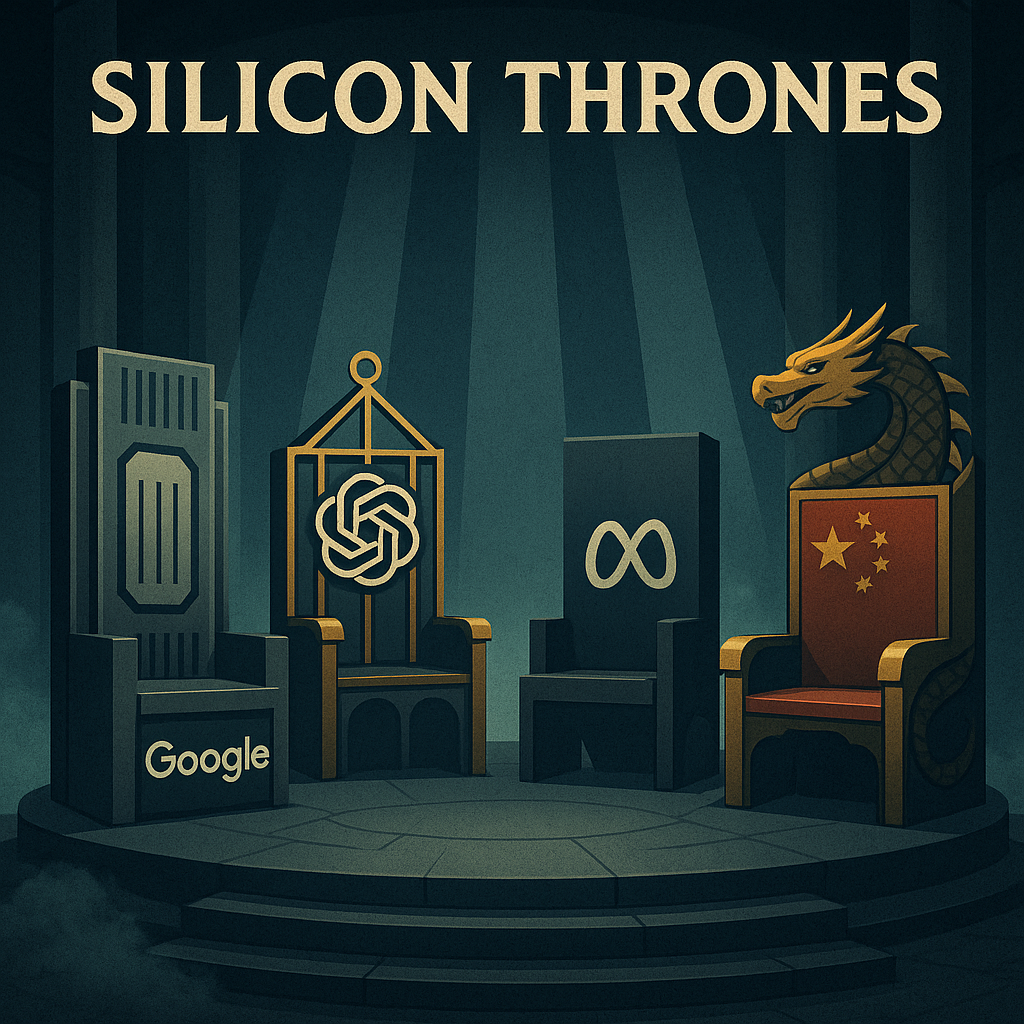The global race for artificial intelligence supremacy has rapidly escalated beyond a simple sprint to build the smartest algorithm. As of mid-2025, it has become a complex geopolitical and economic conflict, a “great game” fought on three distinct fronts: the control of physical infrastructure, the viability of competing economic models, and a ruthless war for human genius. The companies that navigate this treacherous landscape will not only lead the technology sector but will fundamentally shape global commerce and society for the next generation. The key players have settled into their roles: Google, the vertically integrated fortress; OpenAI, the famous but vulnerable pioneer; and the disruptive insurgents, Meta and the state-backed AI champions of China.
At the center of this conflict sits Google, an empire built on a strategy of complete vertical integration. More than any other player, Google owns the entire AI stack, creating a formidable economic and technological moat. This control starts at the most fundamental layer: custom-designed silicon. By engineering their own Tensor Processing Units (TPUs), Google bypasses the exorbitant “Nvidia tax” that competitors must pay for high-end chips, giving them a structural cost advantage that some analysts estimate to be as high as 4-6x. This hardware advantage is housed within a global network of hyper-scale data centers they own and operate. Upon this foundation rests their software: world-class models like the Gemini family for text and reasoning, and Veo3 for video generation. This integrated structure, from the chip to the cloud to the consumer application, allows for a level of performance tuning and cost control that is nearly impossible to replicate. This power is most visible in their aggressive pricing and bundled offerings, like the AI Ultra subscription, which leverages their low marginal costs to provide immense value and lock users into their ecosystem. This physical fortress is further reinforced by a human one, with visionary leaders like Nobel laureate Demis Hassabis acting as a “genius magnet” for top researchers who are drawn to the mission of “solving intelligence” with unparalleled resources. Google’s only vulnerability is that this entire structure is only dominant as long as its models remain at the absolute cutting edge of performance.
Facing this fortress is OpenAI, the brilliant mercenary who, with ChatGPT, ignited the public imagination and started the generative AI revolution. Their greatest asset is their brand. For a significant portion of the world, “AI” is synonymous with “ChatGPT,” giving them a powerful first-mover advantage and immense cultural cachet. Their flagship models, like GPT-4o, are still considered the benchmark for creativity and complex reasoning. However, this pioneering success masks a critical, potentially fatal, weakness: they are renters in a kingdom of landlords. OpenAI’s very existence depends on renting computational power at a staggering scale, primarily from Microsoft’s Azure cloud. This has been described as a gilded cage, the partnership that enabled their meteoric rise now shackles them with infrastructure costs that rival the defense budget of a midsize country. This Achilles’ heel dictates their entire strategy. It explains the recent, visible friction in their relationship with Microsoft and their desperate-yet-brilliant scramble to diversify. By striking new deals to rent compute from rivals, including Google’s more cost-effective TPUs and Oracle’s cloud, OpenAI is attempting to turn its weakness into leverage, pitting the landlords against each other to secure the best rates. It’s a high-stakes play for survival, a prelude to their audacious endgame: Sam Altman’s reported quest to raise trillions of dollars to build his own global network of chip fabs and data centers, the only true path to escaping renter status and achieving sovereignty.
This central conflict is being constantly destabilized by two major disruptive forces. First is Meta’s Mark Zuckerberg, who is waging an insurgency fueled by ideology and immense personal wealth. He is playing the role of a “genius poacher,” personally recruiting top researchers with offers of what could be described as “containers of gold bullion” to join his own AI luminary, Yann LeCun. Meta’s strategic weapon is its open-source philosophy. By releasing powerful models like Llama for the world to use and modify, they are attempting to commoditize the market, preventing the closed-source, high-margin ecosystems of Google and OpenAI from becoming the unquestioned standard. The second, and perhaps more potent, disruptive force is the Chinese national strategy. This is not just corporate competition; it is state-backed industrial policy. Companies like DeepSeek are executing a “scorched earth” pricing strategy, offering models that are nearly as powerful as their Western counterparts for a fraction of the cost, in some cases, 20 times cheaper. While accused of unethically “distilling” their models by training on data produced by Western AI, their state-subsidised mission is clear: achieve global AI dominance by 2030 by becoming the default, low-cost infrastructure on which the world builds.
This is the state of play in the AI great game. It is a three-front war where Google’s integrated empire battles OpenAI’s struggle for independence, while both are constantly undermined by Meta’s open-source insurgency and China’s state-capitalist ambition. The ultimate winner will not simply be the company with the cleverest algorithm, but the one with the most durable and ruthless economic model to power it for decades to come.
Disclaimer: Important Legal and Regulatory Information
This report is for informational purposes only and should not be construed as financial, investment, legal, tax, or professional advice. The views expressed are purely analytical in nature and do not constitute financial guidance, investment recommendations, or a solicitation to buy, sell, or hold any financial instrument, including but not limited to commodities, securities, derivatives, or cryptocurrencies. No part of this publication should be relied upon for financial or investment decisions, and readers should consult a qualified financial advisor or regulated professional before making any decisions. Bretalon LTD is not authorized or regulated by the UK Financial Conduct Authority (FCA) or any other regulatory body and does not conduct activities requiring authorization under the Financial Services and Markets Act 2000 (FSMA), the FCA Handbook, or any equivalent legislation. We do not provide financial intermediation, investment services or portfolio management services. Any references to market conditions, asset performance, or financial trends are purely informational and nothing in this report should be interpreted as an offer, inducement, invitation, or recommendation to engage in any investment activity or transaction. Bretalon LTD and its affiliates accept no liability for any direct, indirect, incidental, consequential, or punitive damages arising from the use of, reliance on, or inability to use this report. No fiduciary duty, client-advisor relationship, or obligation is formed by accessing this publication, and the information herein is subject to change at any time without notice. External links and references included are for informational purposes only, and Bretalon LTD is not responsible for the content, accuracy, or availability of third-party sources. This report is the intellectual property of Bretalon LTD, and unauthorized reproduction, distribution, modification, resale, or commercial use is strictly prohibited. Limited personal, non-commercial use is permitted, but any unauthorized modifications or attributions are expressly forbidden. By accessing this report, you acknowledge and agree to these terms-if you do not accept them, you should disregard this publication in its entirety.



